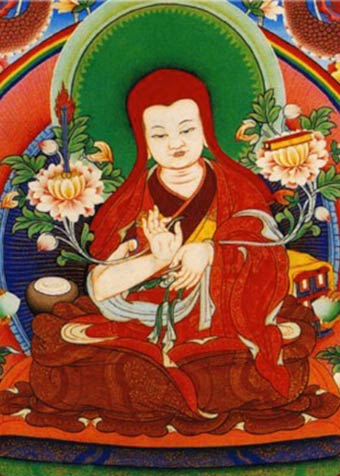果然巴·索南森格於藏歷1429土雞年誕生。尊者從1483年至1486年擔任俄寺第6任法主。
因為其大智慧,果然巴廣泛地被認證為薩迦三祖傑尊·扎巴堅讚的轉世。
As a child Gorampa mastered reading effortlessly. When he attained the age of ten, Gorampa observed that all living beings who dwell in the world are afflicted by many various kinds of sufferings. Hence, he resolved to renounce the world and begged his parents’ permission to do so. He took monastic vows at age eight or ten and continued his early studies. It was recorded that Gorampa’s teachers were extremely impressed with his intellect.
十九歲時,果然巴就已經博通經綸,包括精通因明邏輯和般若密多的教義。接著他前往那爛陀寺,在那裡值遇了偉大的薩迦派大師根欽榮敦(藏:遍知榮地導師),並從其處領受教法。
In his early twenties, Gorampa fell ill and was prevented from going on a tour of various monastic colleges as he had intended. Instead, in 1453, he went to live at Ngor Monastery–Ngor Ewaṃ Choden where he began to study tantra extensively under Ngorchen Kunga Zangpo (founder of the Ngor school). Gorampa was fully ordained when he was twenty-six. He received the full Lam Dre teachings twice as well as many other tantric instructions from Kunga Zangpo and the other teachers at Ngor.
In 1466 Gorampa founded Tanak Serling Monastery, where he stayed and taught for several years, although he also made occasional teaching trips to other monasteries. He wrote prolifically during that period and composed some of his most important works, receiving support from nobles associated with the Rinpung court in Tsang.
In 1473 Gorampa founded another monastery called Tanak Tubten Namgyel, where he established a curriculum that thoroughly addressed both exoteric and esoteric subjects. He taught there for most of the following decade.
1483年,果然巴被加冕成為俄支派第六任主持——俄支堪欽。在位期間他傳授各種顯密教法,特別是道果法,直到1486年退位。
從俄寺法座退位後,果然巴回到達那地方,傳法之餘,嘔心瀝血著書立說,直到生命終結。果然巴於1489年示寂。
Gorampa’s writings fill thirteen volumes. His most well-known and influential work was the Distinguishing of the View, a highly influential study of Tibetan Madhyamaka that describes in detail different interpretations of the Middle Way philosophy debated in Tibetan monasteries.

